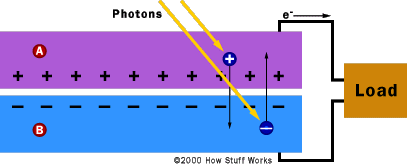|
Converting Photons to Electrons
The solar cells that you see on calculators and satellites are photovoltaic
cells or modules (modules are simply a group of cells electrically connected
and packaged in one frame). Photovoltaics, as the word implies (photo
= light, voltaic = electricity), convert sunlight directly into electricity.
Once used almost exclusively in space, photovoltaics are used more and
more in less exotic ways. They could even power your house. How do these
devices work?
Photovoltaic (PV) cells are made of special materials called semiconductors
such as silicon, which is currently the most commonly used. Basically,
when light strikes the cell, a certain portion of it is absorbed within
the semiconductor material. This means that the energy of the absorbed
light is transferred to the semiconductor. The energy knocks electrons
loose, allowing them to flow freely. PV cells also all have one or more
electric fields that act to force electrons freed by light absorption
to flow in a certain direction. This flow of electrons is a current, and
by placing metal contacts on the top and bottom of the PV cell, we can
draw that current off to use externally. For example, the current can
power a calculator. This current, together with the cell's voltage (which
is a result of its built-in electric field or fields), defines the power
(or wattage) that the solar cell can produce.

When light, in the form of photons, hits our solar cell,
its energy frees electron-hole pairs.
Each photon with enough energy will normally free exactly one electron,
and result in a free hole as well. If this happens close enough to the
electric field, or if free electron and free hole happen to wander into
its range of influence, the field will send the electron to the N side
and the hole to the P side. This causes further disruption of electrical
neutrality, and if we provide an external current path, electrons will
flow through the path to their original side (the P side) to unite with
holes that the electric field sent there, doing work for us along the
way. The electron flow provides the current, and the cell's electric field
causes a voltage. With both current and voltage, we have power, which
is the product of the two.
|